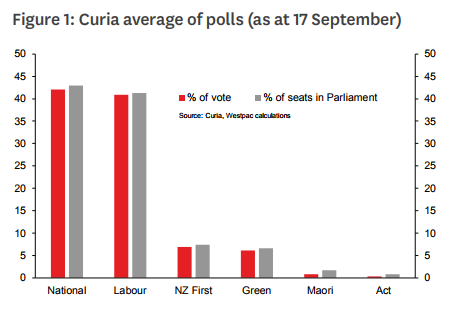Countdown to the New Zealand Election: Views and Potential New Zealand Dollar Reactions

The most likely outcome of the election is a coalition between the largest party, the Nationals, NZF and ACT - and on the margin this would be the better outcome for the New Zealand Dollar.
In the run up to the general election in New Zealand this Saturday, September 23, an average of the latest polls is showing the two main parties are neck-and-neck.
In order to get a ruling majority both parties will probably have to form an alliance, and that alliance will probably have to be with the third largest party, which is likely to be New Zealand First.
The need to form an alliance is the result of a change in the electoral system which requires deals to be struck behind closed doors and policy compromises to be traded in ordern to effectively govern.
This immediately sets up an environment of uncertainty; and if there is one truth in the world of foreign exchange it is that currencies do not like uncertainty.
New Zealand changed its voting system to proportional representation in 1996 and since then, “no single party has won a majority of the seats. Instead, the major parties have had to either enter into a coalition or form a minority government with support agreements from smaller parties,” notes Westpac analyst Dominick Stephens.

New Zealand First (NZF) is a nationalist party as the title implies and whilst both Labour and the ruling National party have policies which could be viewed as anti-kiwi, particularly proposals to broaden the mandate of the Reserve Bank of New Zealand to target not just prices, but employment too.
All three of the largest parties are planning to cap immigration but NZF has the policies which would reduce the number of immigrants the most.
NZF would also stop inbound investment and foreign ownership of NZ assets, tapping into a popular view that foreigners, the Chinese in particular, are driving up house prices.
Taken altogether their policies would result in a substantial fall in demand for the Kiwi and a reduction in economic growth which would lead to further Kiwi weakness.
Their opposition to a capital gains tax, which Labour wants to introduce, is seen as stimulatory along with their other policies, which Westpac describes as “expensive” and these would be expected to stimulate growth and thus be a positive factor for the currency.
Despite the influence they have as probable kingmaker in any coalition deal, however, they would never be in a position where they could get all their policies accepted by the major party they were partnering with, so in the end the impact on the currency would depend on the specific mix eventually implemented.
Plausible Coalitions
As polls currently stand, Westpac argue the most likely outcome of the election is a coalition between the largest party, the Nationals, NZF and ACT – a small one-seat party aligned to the Nationals - to form a three-party majority.
The second most likely possibility, according to Westpac is a Labour-NZF combination, which has a precedent in the 2005 election outcome.
Hhowever, Labour would have to do better than its average poll to reach a majority with the help of NZF alone.
There would be no ‘third partner’ to make up the numbers in the Labour-NZF combo as the Green party is diametrically opposed to NZF and the Maori party also unlikely to want to join a coalition with them.
The third most likely coalition combination includes Labour, the Green party and the Maoris in a combined coalition.
“It is possible that Maori could join Labour and the Greens in a left-of-centre coalition. Based on current polling, the three parties together would command 60 seats in a 122 seat parliament, so a small shift in the polls would be required to allow this combination,” says Westpac’s Stephens about this possibility.
Get up to 5% more foreign exchange by using a specialist provider by getting closer to the real market rate and avoid the gaping spreads charged by your bank for international payments. Learn more here.
Labour’s Policies
The Labour Party has surged in the polls ever since appointing a new leader in the form of Jacinda Ardern and are now only marginally behind the Nationals, and even ahead according to some polls.
Their policies include a more expansive fiscal spending agenda with more money going into education and housing as well as some increased control over immigration, and higher taxes.
Westpac estimate that Labour’s increased spending promises will help stimulate growth but that this will be offset by higher or unchanged taxes.
“Labour plans to run with around $7bn more net core crown debt than is currently budgeted (equivalent to 2.2% of GDP). More expansionary fiscal policy would tend to see us lifting our GDP forecasts, although the cancellation of next year’s tax cuts would have a negative effect on our GDP forecast for that year,” says Stephens.
Their spending plans may not be as aggressive as one might expect, however, as they have also pledged to reduce the level of New Zealand debt to 20bn in five years (it is currently at 22bn).
Labour has promised to reform the Reserve Bank of New Zealand (RBNZ) by making decisions committee-based rather than just down to the governor as is currently the case, and by introducing a new mandate for the RBNZ to support full employment.
Previously these reforms had caused jitters amongst analysts who thought they would infer a more expansive monetary policy agenda, given unemployment remains above its long run average, however, Westpac’s Stephens dismisses them as insignificant in the current monetary conditions.
“Labour plans to introduce a committee for making monetary policy decisions, with a mix of internal and external members and published minutes, similar to the Bank of England model. Labour also plans to give the RBNZ a dual mandate to target full employment as well as price stability. The employment target would not be numerical. We doubt these changes would make much difference to the conduct of monetary policy,” said Stephens.
Labour’s policies in relation to housing may be more of concern for financial markets, as they may weigh on the growth of the extremely buoyant housing sector.
They wish to reduce speculation by imposing a tax on property investors reselling a property with five years of purchase (up from the current two), they will not allow them to write off loses from their rental properties against their income, and to review capital gains tax.
However, offsetting the limits on speculation are plans to build 100k new homes, which would increase construction activity and GDP.
Election Impact on the Kiwi
Previous analysts have been fairly negative about the outlook for the Kiwi in the run up to the election, seeing the event as a ‘lose-lose’ for the currency, but Westpac’s Stephens presents a more nuanced picture.
Whilst it would be true that a government with a nationalist orientation and sever limits on foreign investment as well as immigration such as would occur if NZF were to share power, would probably impact negatively on the currency, much would depend on which policies were allowed by the coalition partner, and whether their impact on growth was an offsetting factor.
Labour’s policies represent a mixed bag of pro-growth, relatively high tax policies, which are probably net neutral for the Kiwi.
In general, however, a lurch right from the electorate towards NZF and the Nationals is likely to restrict growth and immigration to such an extent that the RBNZ may well feel it has to turn more dovish to make up for a lack of growth friendly strategies from the government, leading to a depreciation in the Kiwi.
The same is likely to be true but positive for the currency in the event of a general lurch ‘left’ by the electorate towards Labour and the Greens.




